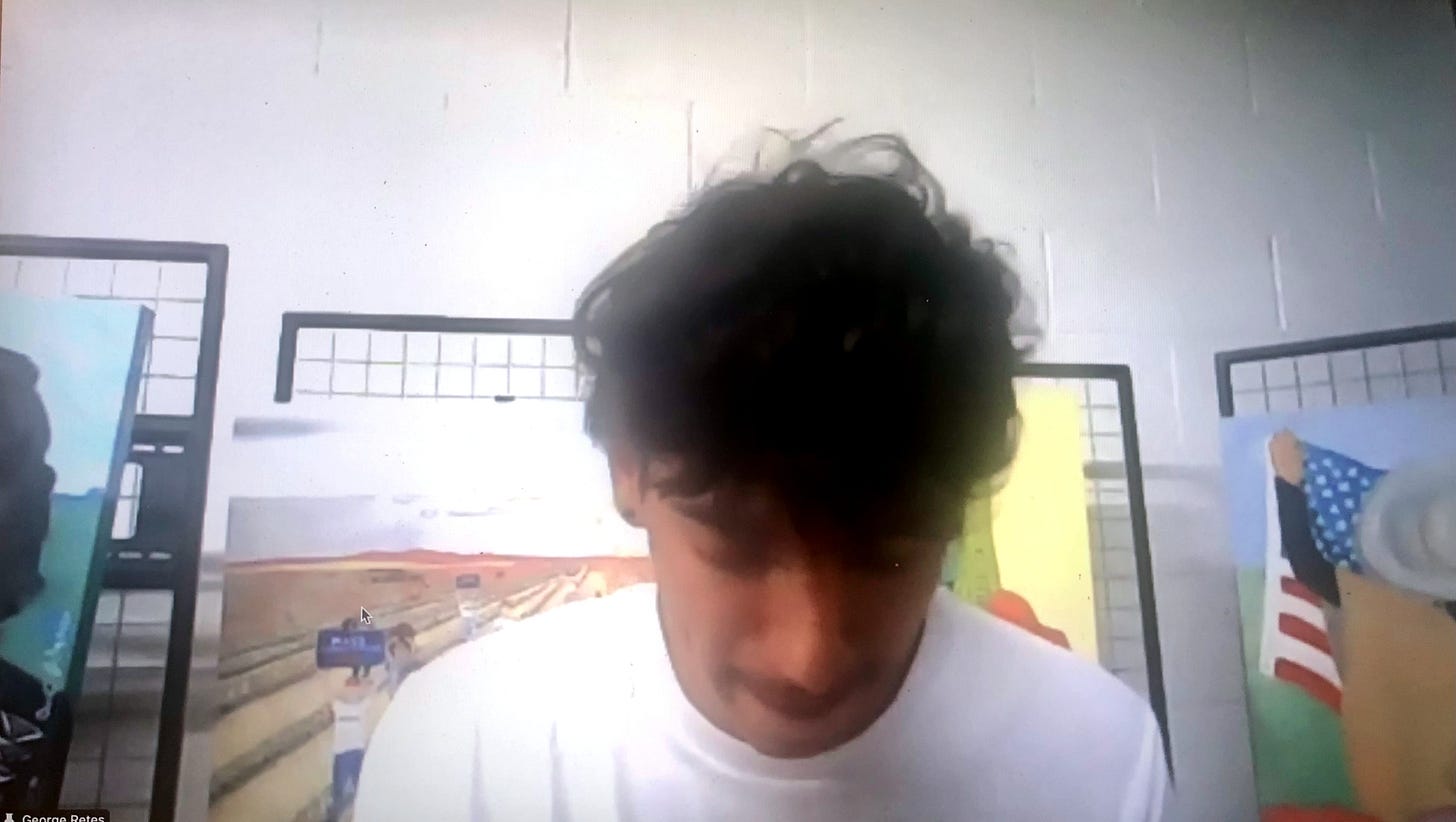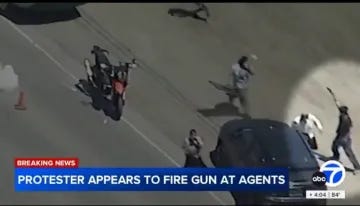Ventura Veteran George Retes speaks after three days in ICE detention
Retes was trying to get to work on July 10th. He ended up in federal custody, covered in pepper spray. Plus: a dive into the federal narrative.
This story was updated at 3 p.m. on July 20th to include an additional statement from Ventura County Sheriff Jim Fryhoff.
Greetings readers! Two quick notes: I’ve been posting reporting updates on Substack notes and on Instagram. Please follow me on those platforms if you’re interested in such things. Also: I’m participating in an Ojai Chautauqua panel discussion on the future of Ojai on July 31st, if you’re interested in that sort of thing. I’ve moderated panels before, but I’ve never actually been part of one.
Onward to today’s story.
George Retes, a 25-year-old Ventura native, drove to work at Glass House Farms' Camarillo location around 2 p.m. on July 10th, like usual.
Retes works at the farm as a security guard. He’s employed by security firm Securitas.

As Retes approached the Laguna Road farm last Thursday, he witnessed a shocking and chaotic scene: military vehicles, masked ICE officials, police, FBI, the national guard, protestors, and community members — all assembled around his workplace. News helicopters and at least one U.S. Customs and Border Patrol helicopter were circling the scene from above.
Federal agents in military gear were simultaneously raiding Glass House Farms’ Carpinteria location, according to the Santa Barbara Independent. Video from the incident shows another chaotic scene: smoke, a crying child, violence, and expletives. In one witness' words:
“Fuck. What the fuck! He’s got a fucking flash bang! In Carpinteria!”
U.S. Congressman Salud Carbajal — who represents most of the Ojai Valley in the U.S. House of Representatives —said he was denied entry to the Carpinteria farm.1
Ojai resident Fabian Castel was driving to a meeting in Santa Barbara when he was stopped by federal agents blocking traffic to the Carpinteria farm at the intersection of Highways 150 and 192.
“This is such a metaphor for freedom. It's like suddenly, yeah, there is no freedom. No, you are not going to move around the way you want,” Castel, a U.S. citizen who was born in France, reflected.
Let’s get back to Camarillo — where Retes is still trying to get to work. ABC7 helicopter footage shows part of the story: it’s about 2:30 p.m, and Retes, driving a white sedan, slowly approaches a line of officers. He exits his vehicle and addresses the officers as they move in a line toward him.
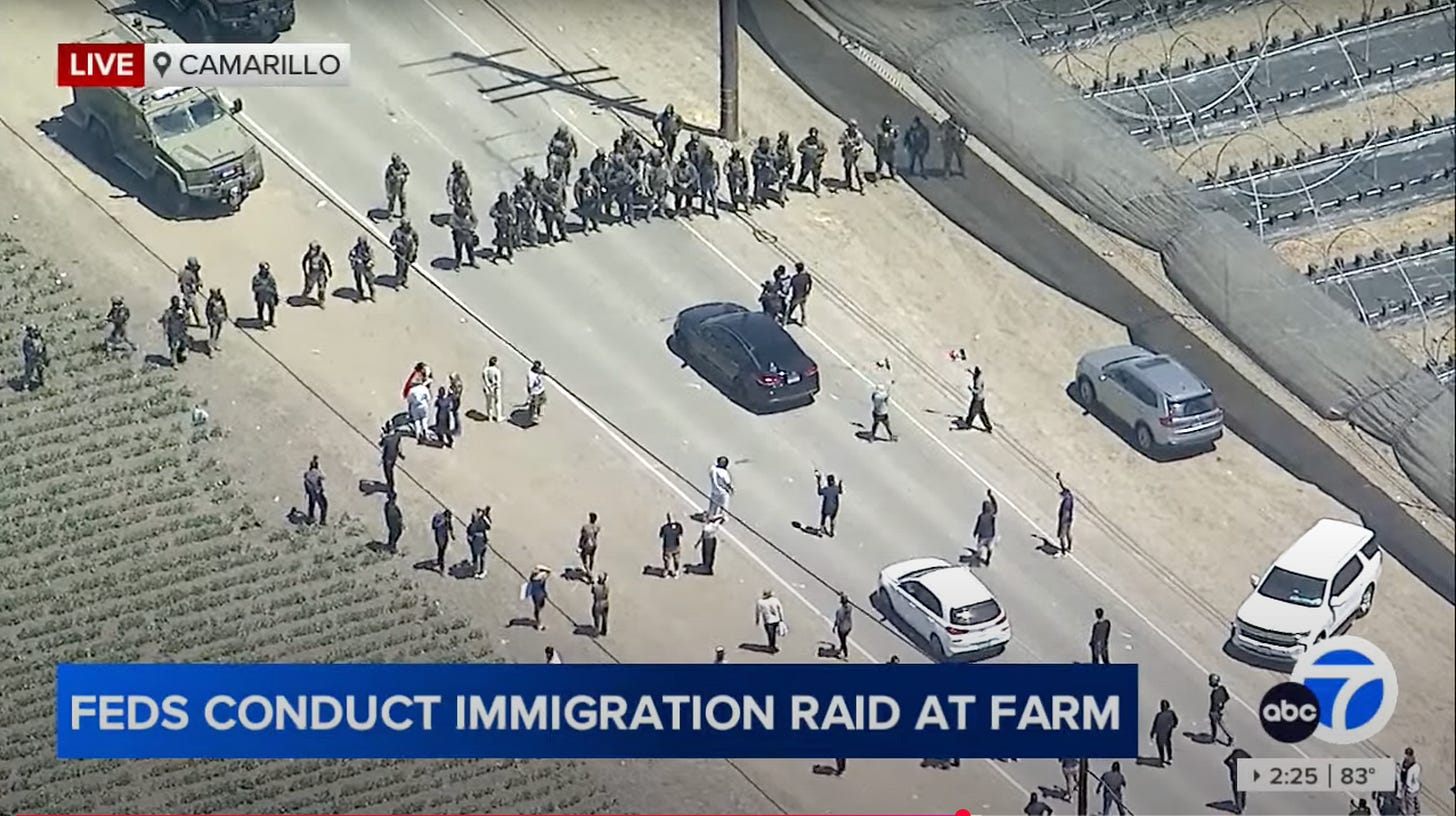
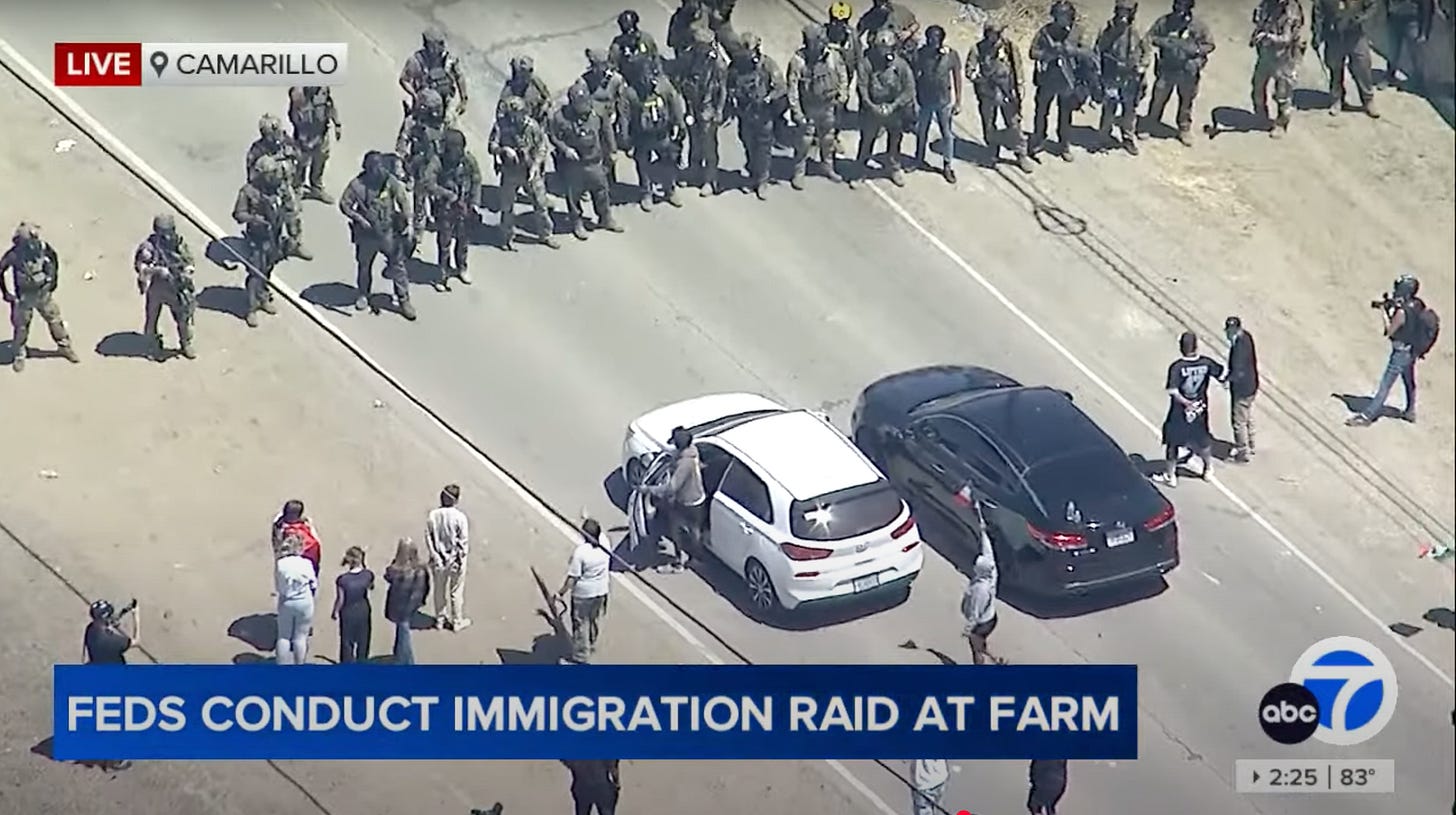
Helicopter footage shows Retes get back into his car and began reversing. Officers begin deploying smoke bombs and tear gas to disperse the crowd. Readers can watch the scene below. Remember: Retes is in the white car.
“I got caught in the middle between the protest and ICE agents,” Retes explained during a July 16th press conference hosted by the United Farm Workers. “I let the ICE agents know that I'm a US citizen, that I'm American, that I work at the Glass House, and they ignored me. They didn't care what I had to say,” Retes said.
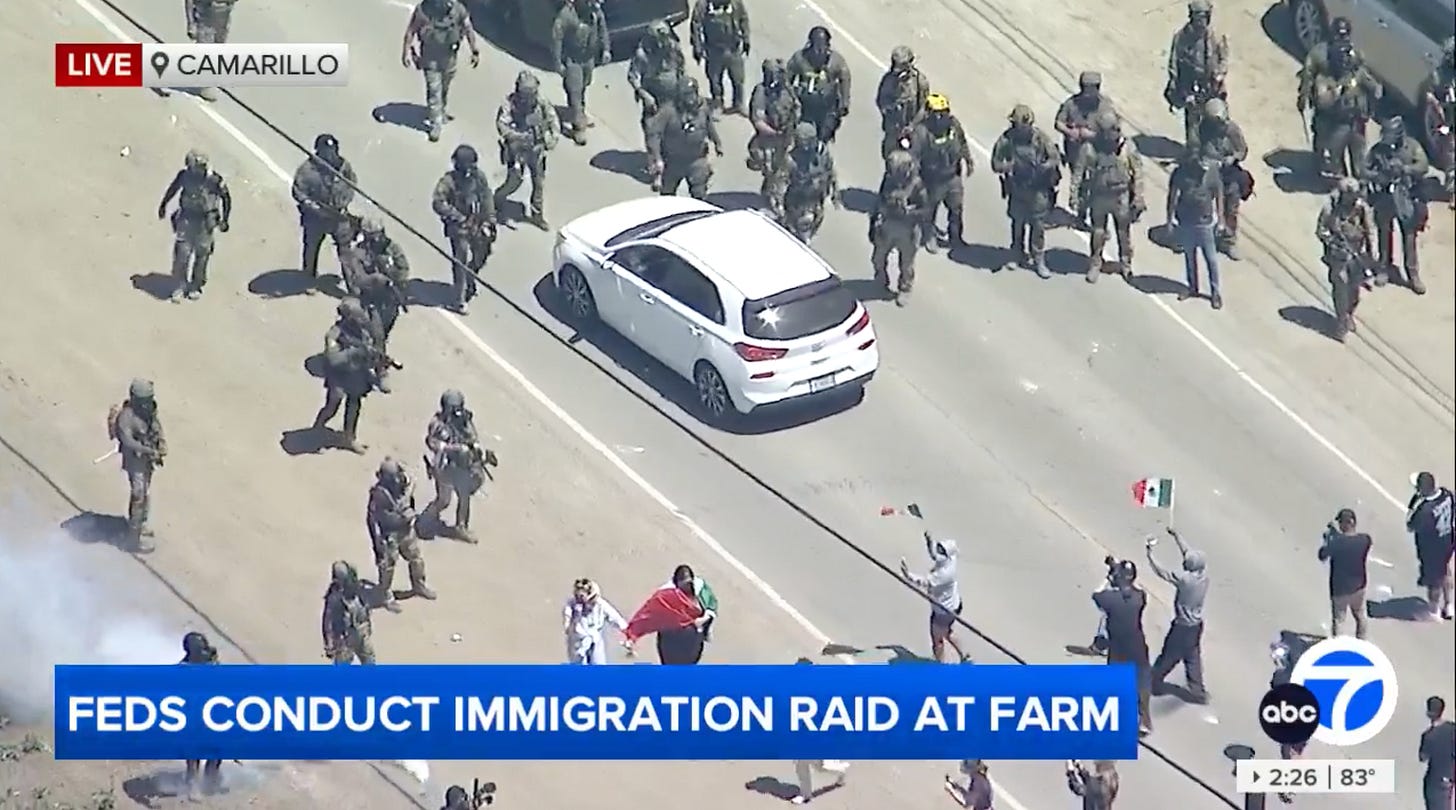
The ICE officers escalated the situation, Retes said. “As you can see in the videos. Some are telling me to reverse, some are trying to rip my door open, some are banging on my windshield.”
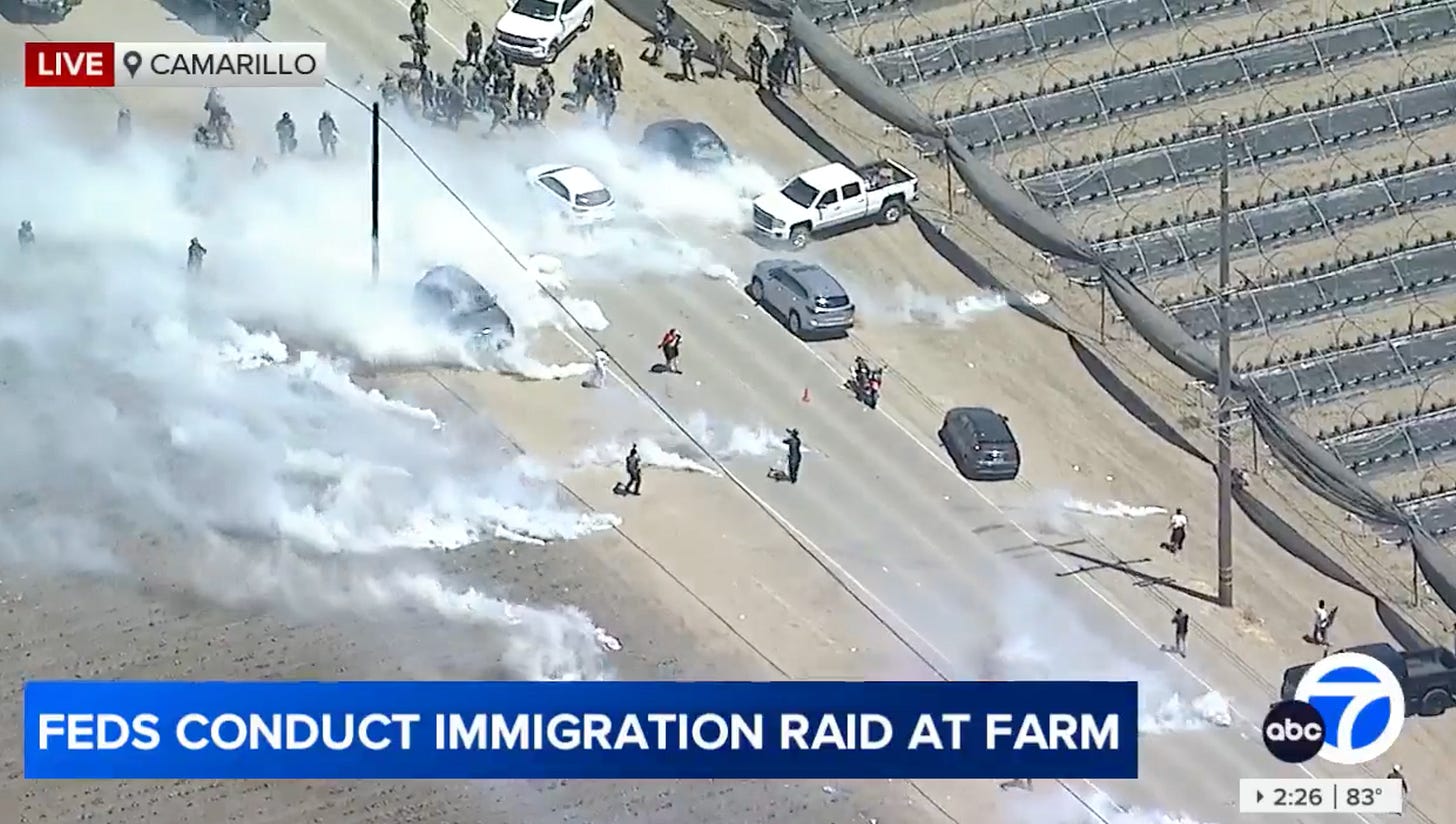
Next, Retes said, an ICE officer broke his driver’s door window, sprayed him with pepper spray, and pulled him out of the vehicle. He doesn’t know if he was pulled from his car through the broken window or the car door — just that he was dragged.
While he was on the ground, one ICE officer kneeled on his back. A second officer kneeled on his neck, “all while multiple other ICE agents stood around and just watched 'em do it,” Retes told me during a July 17th interview. “Because of the tear gas, I couldn't catch my breath or anything, and I was pleading with them to get off of me. I couldn't breathe and they didn't care.”
ICE officials then zip tied Retes’ hands behind his back. He sat on the Glass House Farms property, in the dirt, for hours, he said.
Retes told me he was eventually taken to an unmarked SUV, hands still secured behind him with a zip tie. There were no other detainees in the vehicle. “They had two other people, two U.S. citizens arrested, but they put us in different cars,” Retes said.
Retes’ next stop was the Naval Base of Ventura County in Port Hueneme, he said. There, he was fingerprinted, photographed, and the zip tie around his wrists was replaced with metal handcuffs. His legs were cuffed too, he said.
Retes was then returned to the unmarked SUV. He was transported to a federal building in downtown Los Angeles – hands and feet cuffed. “If I’m being honest, I don't even know it was an ICE detention center. It honestly looked like a normal prison to me,” he remarked. Retes isn’t sure which building he was held in — but the Metropolitan Detention Center Los Angeles fits his description.
Once he arrived at the detention center, Retes was given a prison uniform. He still had pepper spray on his body, he said. “They didn't give us a phone call. They didn't let us talk to an attorney. They didn't let us shower. They just threw us in a cell,” he said.
Retes spent the night of July 10th in a cell with one other man — a professor from Cal State Channel Islands and a fellow U.S. citizen, he said. Retes didn’t sleep at all that night — his hands were still burning from the pepper spray. “I let [the guards] know that. They said that it would pass.” It didn’t pass, Retes said.
On July 11th, Retes communicated to guards that he was worried he might harm himself. He was placed on suicide watch and relocated to another cell, alone. Retes’ state of mind, he told me, was a result of his situation, explaining “... just kind of after everything that had happened to me and missing my daughter's birthday and everything and not knowing what was going to happen to me, not knowing if my family knew where I was at or anything. It was just a lot…”
Retes’ daughter turned three years old on Saturday, July 12th, while her dad was held in federal custody. Retes is also the father to an eight-year-old.
During his three-day incarceration, Retes ate “prison food.” One such meal, he said, consisted of a bologna sandwich and a slice of fruit. “I had to fill up my sink with water and drink out of the sink,” he added. The building was warm — there were times he woke up sweating.
Retes remained incarcerated until Sunday, July 13th.
That’s when an officer approached his cell and told him he would be released that day, Retes said. “I waited a few hours and then they finally came [back] and an officer walked me, walked me downstairs and then I signed a paper to get my stuff back and that was it. They let me go,” he recounted. “When I was released they said that they dropped the charges on me.”
Once free, Retes called his wife — he hadn’t been able to communicate to any of his family members since Thursday. Retes still doesn’t know why he was detained.
“That'd be a question for them, not me,” he said. What I do think is that they need more fucking training. They clearly can't handle their own emotion, and that's not right. Especially if you're going to be a law enforcement officer, you should be able to control yourself.”
The Aftermath
Upon his release, Retes learned he was a national news story.
“It's unbelievable,” he told me. “I didn't know what was going on while I was locked up on the inside. I just kind of assumed that I was going to get taken away and no one was ever going to hear from me again.
“So when I did get released and found out my story was everywhere, I just felt so thankful and I just appreciate everyone who's shared my story because it was because of all them and all of you guys sharing my story. It's the reason that I was released. You guys shed light on everything that had happened and you guys are the ones that saved me. And so I'm thankful for all of you guys.”
Retes said that he plans to sue the government for violating his rights. “I do plan on filing a lawsuit,” he told a crowd of reporters via Zoom. “I do hope they learn after. I hope they learn that what they did wasn't right and the only way they will learn is through a lawsuit... I hope this never happens to anyone again.”
The DHS Narrative
The U.S. Department of Homeland Security (ICE is part of DHS) issued a dramatic public statement on July 11th, the day after the raids.2 Take a look at the headline:

The DHS release includes an image — a screenshot from the ABC7 news helicopter footage — showing a man who appears to be pointing a gun at federal officers.
The Ventura County Sheriff’s Office shared a similar image, alongside helicopter footage of the incident, and a lengthy statement from Ventura County Sheriff Jim Fryhoff. (You may remember Fryhoff as Ojai’s former Chief of Police.) His statement reads, in part:
“Immigration and Customs Enforcement (ICE) agents notified our agency of this operation, for officer safety purposes, fifteen minutes before the execution of their search warrant. The search warrant stemmed from the business hiring illegal immigrants. The Ventura County Sheriff’s Office was not involved in this operation until the FBI called and requested assistance, advising that agents were being attacked by protestors. The FBI advised us that they had deployed gas and munitions and that they needed help.”
In response to this “dynamic and dangerous situation,” Fryhoff wrote, the Sheriff’s office sent its tactical response team “to keep the peace between protestors and federal agents” and “[get] federal agents and their arrestees out of the area safely.”
Fryhoff then refers to the ABC7 helicopter footage, stating the video “clearly highlights the severity of the violence that can occur during these types of incidents. The video depicts an individual brandishing a handgun, seemingly aiming and firing in the direction of the opposing federal agents. While no form of violence during protests is ever acceptable, this reprehensible and cowardly act is utterly intolerable and must not be condoned by anyone.”
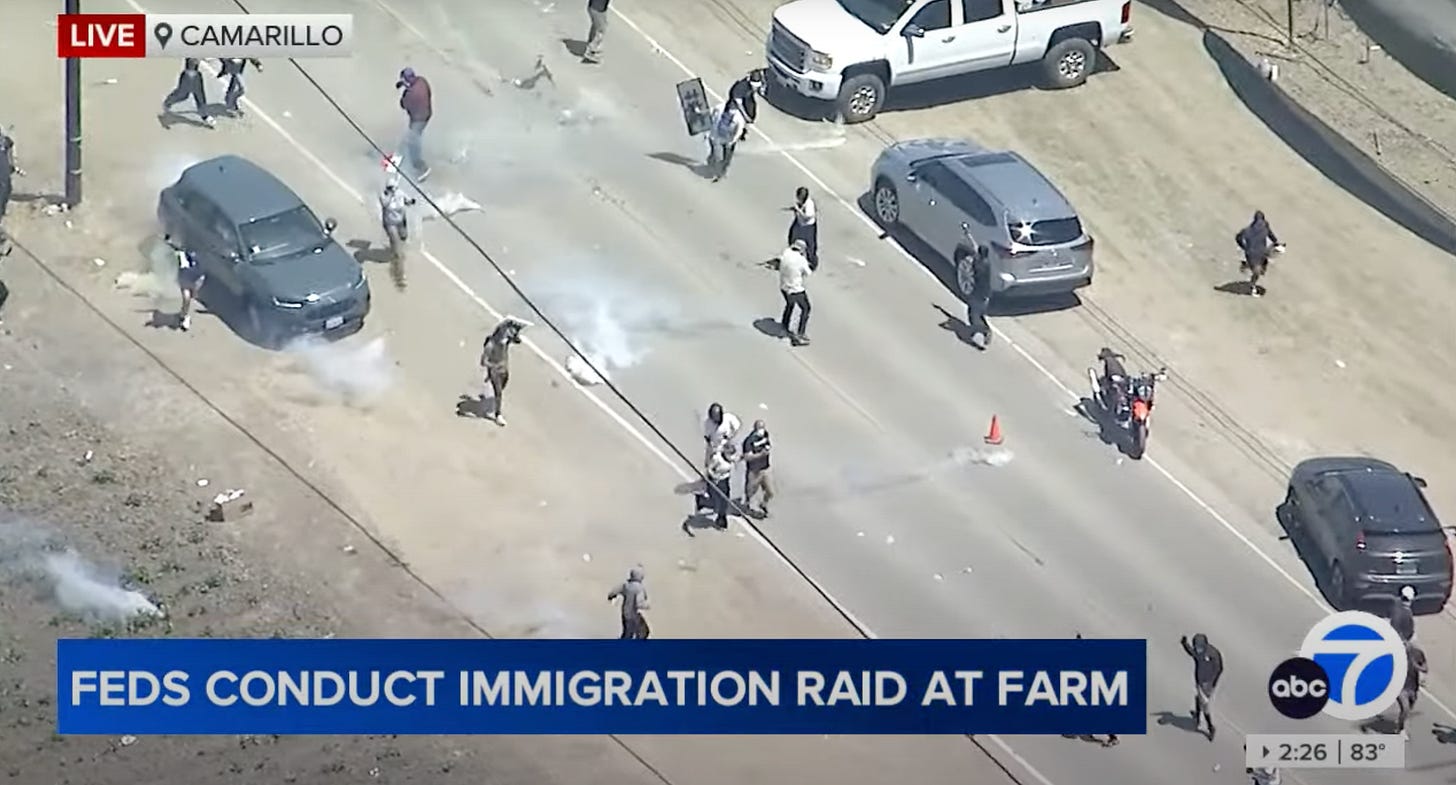
But what about the violence Retes says he experienced at the hand of federal officers? I had the opportunity to ask Fryhoff that question on July 20th.
“My expectation is if a [VCSO] deputy saw anybody, including a federal agent using obviously excessive force, that they would step in and stop it from happening… If I saw a federal officer engaging in gross misconduct, yes, our officers would intervene,” he said.
Let’s get back to DHS’ narrative. The federal agency asserted in its July 11th statement that federal officers arrested approximately “200 illegal aliens” between both sites and “rescued” at least “10 migrant children.” DHS further claimed that “more than 500 rioters attempted to disrupt operations” and “four U.S. citizens are being criminally processed for assaulting or resisting officers.” Given Retes’ experience, this statement begs some skepticism.
By July 13th — DHS revised its numbers. 200 became 361 and 10 turned into 14.

The July 13th news release includes the images of three men and the name of one woman, with various criminal convictions listed alongside. The release also states that “at least 14 migrant children have been rescued from potential exploitation, forced labor, and human trafficking.”
Migrant children are very vulnerable to labor exploitation in the United States. Take a look at this 2023 New York Times investigation.
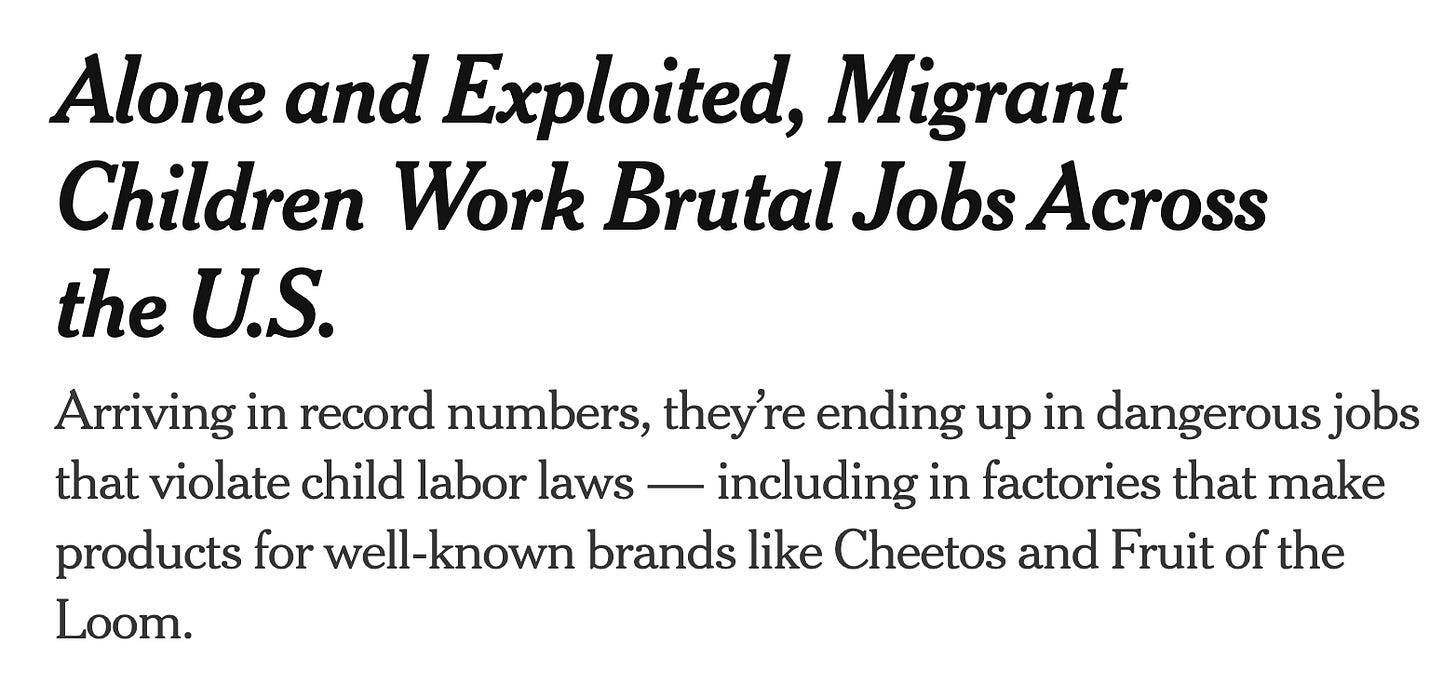
In fact, in California, children as young as 12 can work in agriculture outside of school hours, with parental permission. However, employees in legal cannabis businesses are required to be 21 or older.
A subsequent July 14th press release from DHS provided an update on those young people, stating “ICE has transferred 10 of the children who are unaccompanied to the U.S. Department of Health and Human Services (HHS).”

They’re referring specifically to the Office of Refugee Resettlement (ORR), an agency within HHS. (Much like ICE is an agency within the Department of Homeland Security.) ORR’s stated mission is “to promote the health, well-being, and stability of refugees, unaccompanied alien children, and other eligible individuals and families.” It’s basically a foster care system for migrant children who are in the United States without a parent or guardian.
During the first Trump Administration, ORR became responsible for migrant children who were separated from their families under the president’s “zero-tolerance” immigration policy — also known as “family separation.” A 2024 Human Rights Watch investigation found that six years later, as many as 1,360 migrant children have yet to be reunited with their parents. A 2023 HHS audit raised its own concerns about migrant kids being exploited for labor by ORR sponsors.
DHS sent out a second press statement on the 14th — this one directly targeting Ojai-area Congressman Salud Carbajal. (Recall that he was unable to enter the Carpenteria farm during the July 10th raid.)

Before we get into the content of this statement, I must share an observation about all of these DHS press statements: there is no press contact. There is no opportunity for a member of the public or press to inquire about or clarify DHS’ account of the raids. I can say from experience: this is very strange.
Anyways — DHS alleges that Congressman Carbajal, while attempting to investigate the ICE raid in his district, showed an ICE public affairs specialist’s business card to “the mob” thereby “making a target out of him.”3
The press release contains an image of an individual’s hand with a small, bloody injury. According DHS, the man had to receive stitches.
“The actions by Representative Carbajal are downright un-American,” DHS’ Assistant Secretary for Public Affairs Tricia McLaughlin said in a statement. “He dares to claim that his actions were simply congressional oversight, but doxing ICE personnel and inciting a mob of rioters to attack law enforcement is NOT oversight—it's abominable.”
Here’s my second observation: there’s a simple story across all of these press statements. In DHS’ telling, “brave” ICE agents are heroes and violent “rioters” and “illegals” are the enemies. Anyone who questions the operation, like Rep. Carbajal, is “un-American.” To state the obvious: these documents don’t present a narrative of all facts, but a story to support a political agenda.
I want to close with one final note. Someone did lose his life as a result of the July 10th raids: Jaime Alanis, a Camarillo farmworker, died after falling 30 feet from the roof of a Glass House Farms greenhouse on July 10th.
According to a statement from his family on social media, “His death is not an isolated tragedy. It is the result of a targeted raid at Glass House Farms. Workers were met not with protection, but with chaos and fear. Some were detained. Others were traumatized. Jaime lost his life.”
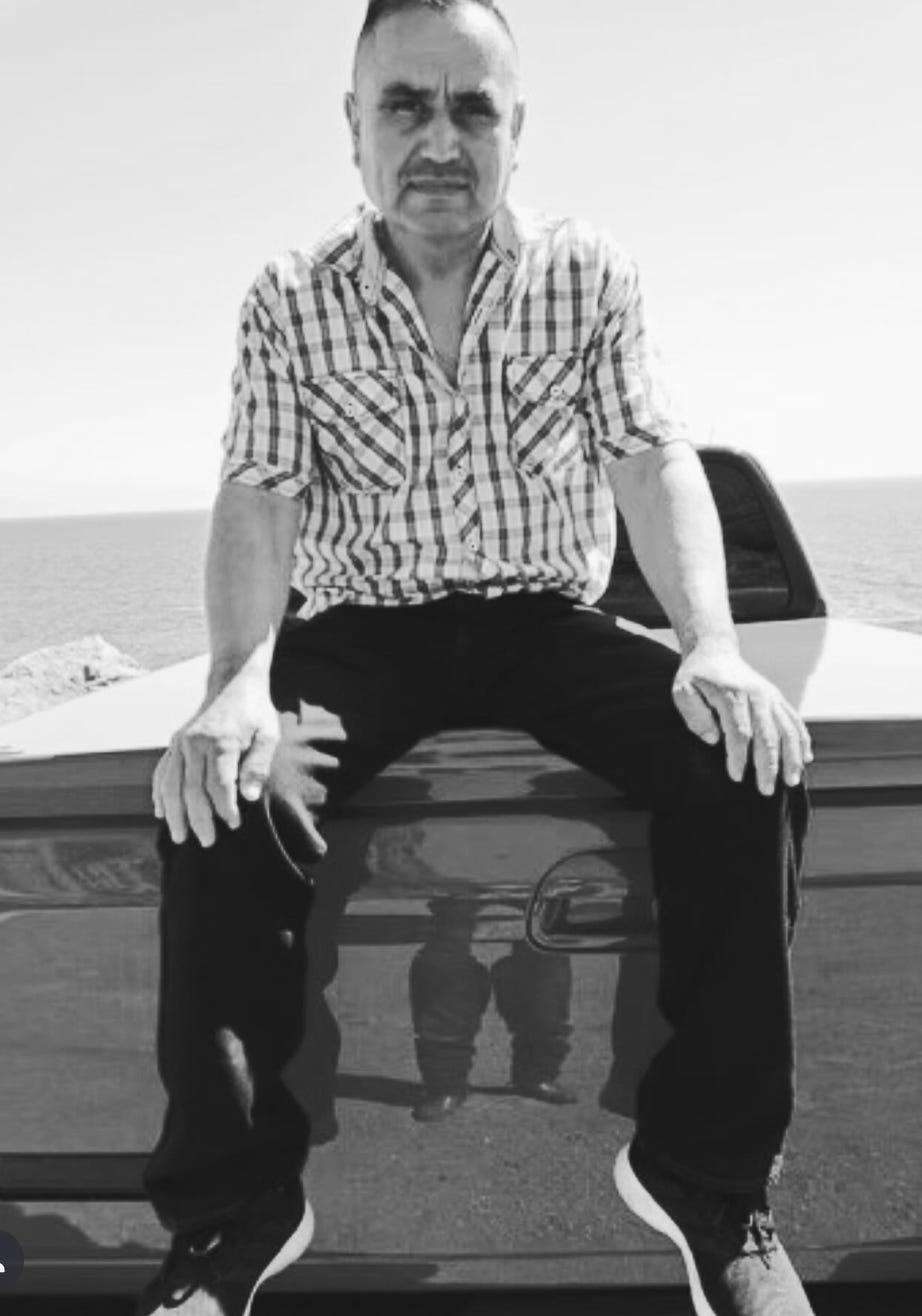
The Department of Homeland Security, via X, stated, “This man was not in and has not been in CBP or ICE custody. Although he was not being pursued by law enforcement, this individual climbed up to the roof of a green house and fell 30 feet. CBP immediately called a medivac to the scene to get him care as quickly as possible.”
According to ABC7, Mexican president Claudia Sheinbaum is considering filing a legal complaint over Alanis’ death.
That’s all for today. As always, thank you for being here. Let’s take care of each other.
Quick civics lesson: Congress appropriates money to the executive branch — ICE being part of the executive branch. The Constitution gives Congress the power to investigate executive branch activities to ensure those tax dollars are spent in accordance with the laws. It’s called oversight. Carbajal (and all of the people he represents) were denied the ability to observe an operation that we collectively funded.
Remember: DHS — and ICE with it — were created in 2003, in the aftermath of September 11th, 2001.
Honestly — I don’t understand this narrative. How does a mob read a business card? Why was a public affairs specialist on the scene for a military operation? These are the questions I’d ask of a press contact, if there was one.

